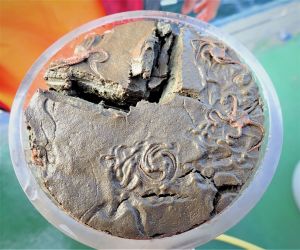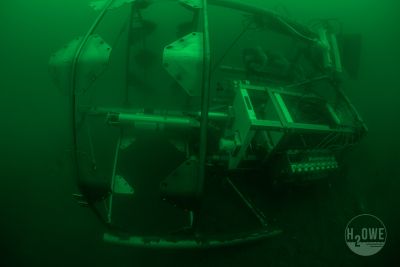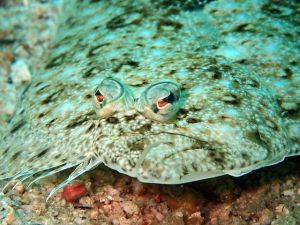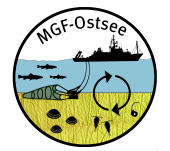First successful cruises completed

The first cruises within our project are already done. We spoke with the expedition leaders of the Elisabeth Mann Borgese 238 cruise, Mayya Gogina and Mischa Schönke about their impressions on board. Also Daniel Oesterwind and Michael Kriegel from Thünen-Institute have carried out their first cruises with Clupea and Solea. Here they tell how it was.
„A fisherman catched BIGO“
"The expedition with Elisabeth Mann Borgese (EMB) turned out to be surprisingly successful. The willingness to do everything possible to carry out the planned work was remarkable from the entire team,” Mayya Gogina says. Mischa Schönke adds: “Everyone was highly motivated and we quickly found a common rhythm. Thanks to the good weather and the fact that the sediment could be sampled better than assumed beforehand, we were able to take so many samples that the small sample containers were just enough."
In the project Mayya investigates the community structure and biodiversity of macrofauna living on and in the seabed. "Macrofauna" is a group of different invertebrate species with a small size of about 0.5 mm to 50 mm. An example is the mussel Arctica islandica. To sample the sediment and its fauna on the sea floor, Mayya uses large sampling equipment that the ship lets into the water via wire.
Mayya has been the chief scientist on several occasions. "But the preparations and the implmentation of the cruise have never been as stressful and exciting as this time," she says. The planning and logistics due to the new COVID-19 conditions were a real challenge: the number of researchers on board was limited to seven people and each participant had to prove two negative corona tests before starting the journey. Shaking hands, hugging - everything was not allowed.

“The test in advance is the key to ensuring that research cruises can take place in Corona times. Keeping one's distance and face mask can only be implemented to a limited extent on board, ” Mischa says.
The young geophysicist has already been on many trips, but now for the first time as chief scientist. "But the very first trip as chief scientist was particularly challenging for me". In addition to his own program, the measurement of the seabed, which was supposed to be used to determine the sampling stations, Mischa now had to lead a team from different disciplines and had to discuss the daily plans with the ship's command at the same time. However, Mischa had never put the new measuring devices into operation himself. “You can plan and test a lot in advance and everything turns out differently on board. So I was relieved when my equipment was set up and the team worked well together." Then on the evening before last, something completely unexpected happened.
“It was 11:20 pm on June 7th, 2020, just one more day at sea,” Mayya begins to tell. “Some people were sitting together and talked about the successful trip. But then suddenly Captain Tino Kaufmann came into the laboratory:“ I think a fisherman caught our BIGO-Lander with his nets despite all the warnings!
BIGO (BIGO = Biogeochemical Observatory) is a gear used to measure material flows, e.g. oxygen, nitrate or nitrite on the sea floor.
The scientists then went to the bridge to see how the fisherman tried to get his boat out of the danger zone. At 2 a.m. the fisher was successful to free itself, but the buoy line, which was attached to BIGOs surface marking and flashing light was gone. This buoy line is used to recover the device, but now it was no longer possible to recover BIGO. Hence, a diving team from Kiel was hired (Submaris), who dived down to BIGO and attached a new line. Finally, and thanks to Submaris, BIGO could brought back on deck using a ship's crane.
The mechanical damage to BIGO was unfortunately pretty obvious. During the maneuver with the fisherman he must have fallen on his side and been dragged along the bottom.
“I think a higher surface mark is nessessary the next time we work in an area with such high fishing activity," Mayya concludes.

On fishing
Two expetions have already taken place with the fishery research vessels Clupea and Solea from the Thünen-Institute. Aim: recording the fish communities.
Ph.D. student Michael Kriegl collected fish samples on trips to Fehmarnbelt and Oderbank. He examines the biodiversity, food ecology and maturity of the fish fauna in the two extremely different study areas. On board the species of the fishes were determined. Also the fishes were weighed and measured. This gave Michael a good overview of the fish communities in the project areas.
His first impressions: “The fish fauna in the protected area of Fehmarnbelt is comparatively diverse, we were able to detect more than 20 different fish species there.”
“Due to the lower salinity of Oderbank further east, the fish fauna in this area is significantly different. Compared to Fehmarnbelt, we find far fewer fish species here, ”adds Michael's supervisor Daniel Oesterwind.
In addition to all kinds of fish, a large number of other samples, from microscopic phytoplankton to larger, bottom-living invertebrate organisms, were taken for food web analyzes by colleague Martin Paar. In addition, plenty of samples of the mussel Arctica islandica were collected for the colleagues Stefan Forster and Martin Powilleit (all Rostock University).
Daniel Oesterwind explains how numerous Arctica can be found in the study areas around the Fehmarnbelt: "In the Fehmarnbelt, our nets filled up with Arctica mussels so quickly that we had to stop fishing after just 3 minutes to prevent the net from breaking."
The next trip is due in January 2021 and the scientists at Thünen-Institute are already excited to see what will be catched next time.

